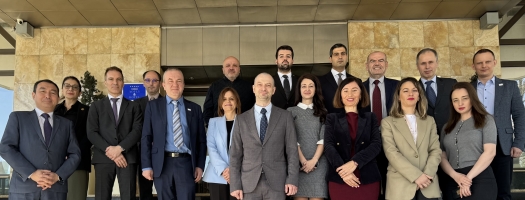Strategic cooperation through national action plans and regional coordination advances chemical, biological, radiological and nuclear (CBRN) preparedness in Southeast and Eastern Europe
The safe handling of CBRN materials is essential to protect public health, national security and regional stability. While these materials have beneficial applications in medicine, agriculture and industry, they also pose significant risks when mismanaged or used maliciously by criminal or terrorist groups, particularly in conflict settings. With growing geopolitical challenges and evolving threats, strengthening regional cooperation and preparedness is more critical than ever.
Within the framework of the European Union CBRN Centres of Excellence (CoE) Initiative, National Focal Points (NFPs) from Southeast and Eastern Europe (SEEE) convened in North Macedonia from 19 to 21 March 2025 for a Strategic Coordination Meeting. The event gathered experts and officials from ten SEEE countries alongside international partners to share successes, assess emerging risks and reinforce regional coordination on CBRN safety and security.
Enhancing National Preparedness through Strategic Action
North Macedonia, as the host country, presented its CBRN National Coordination Body and National Action Plan, showcasing best practices in interagency cooperation and emergency response planning. These frameworks have significantly enhanced national preparedness, serving as a model for other SEEE countries striving to establish effective CBRN risk mitigation structures.
The Strategic Coordination Meeting also featured an annual progress update from the NFPs, highlighting strides made through the EU CBRN Risk Mitigation CoE Initiative. This platform has played a pivotal role in supporting countries to tailor national policies, develop infrastructure and align their strategies with international standards. However, common regional challenges persist, including the need for advanced detection technologies, enhanced biosafety measures and improved cross-border coordination.
During the meetings, the European Commission’s Joint Research Centre (JRC) shared insights on best practices and concrete actions to advance the development and implementation of National Action Plans.
Adapting to Emerging Threats and Future Challenges
A major focus of the meeting was the mid-term review of the SEEE CBRN Regional Action Plan (RAP), initially developed in 2022. The geopolitical landscape has shifted dramatically since then, which has introduced new CBRN security risks, particularly due to the ongoing war in Ukraine. The review underscored the urgent need to update the RAP to include trafficking of hazardous materials, industrial sabotage and the vulnerabilities of nuclear and chemical facilities.
The revised RAP will integrate these emerging risks while phasing out previously addressed priorities. This dynamic approach ensures that regional strategies remain relevant and responsive. The updated plan will be formally validated during the next Strategic Coordination Meeting, reinforcing SEEE’s commitment to collective security.
Building Capacity Building and Driving Innovation Through New Initiatives
In addition to policy advances, the Strategic Coordination Meeting presented key projects designed to enhance regional CBRN response capabilities:
- e-Novation Project: Focused on equipping first responders with cutting-edge technologies to detect and neutralize CBRN threats efficiently.
- Food Safety and Defence Initiative: Set to launch in 2026, this programme will safeguard food supply chains from contamination risks, bolstering national and regional food security.
- EU CBRN CoE Projects: Ongoing initiatives such as Project 88 (Medical Preparedness), Project 100 (Biosafety and Biosecurity) and Project 110 (One Health Secure) continue to strengthen SEEE’s resilience against CBRN-related public health threats.
Strengthening Regional Cooperation through Field Exercises
Looking ahead, the Border Shield 2025 regional field exercise will take place in October this year. This large-scale simulation - marking the 15th anniversary of the EU CBRN CoE Initiative - will engage all ten SEEE countries in a coordinated response to a simulated cross-border CBRN incident. The exercise will test emergency response protocols, foster interagency collaboration and enhance operational readiness, reinforcing the region’s capacity to manage real-world CBRN threats.
Sustaining Momentum and Ensuring Long-Term Impact
The Strategic Coordination Meeting concluded with the election of a new Deputy Head of the SEEE CBRN Regional Secretariat, ensuring continuity in regional leadership.
As SEEE moves forward, sustained investment in strategic planning, innovation and capacity-building remains essential to mitigating evolving CBRN risks. Through coordinated efforts and continued regional engagement, the SEEE region is well positioned to uphold CBRN safety and security in an increasingly complex global landscape.
Learn more about the EU CBRN CoE Initiative.
